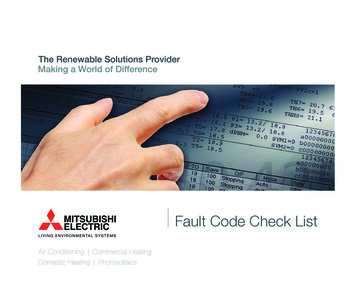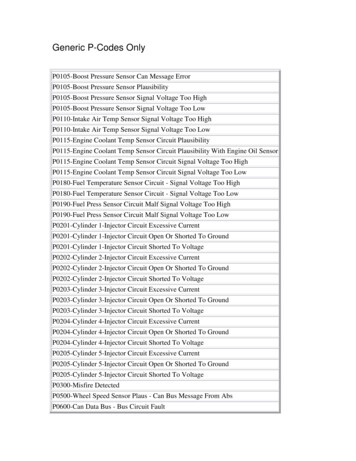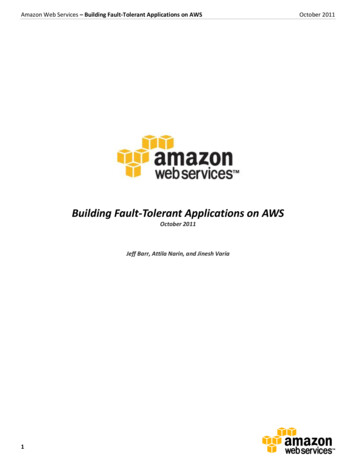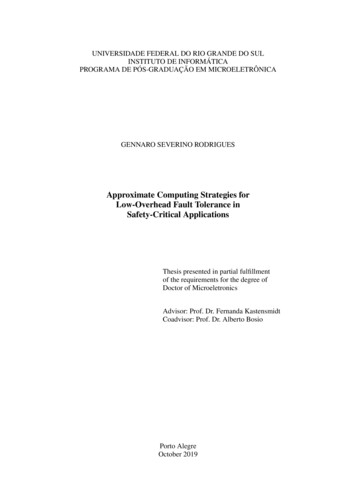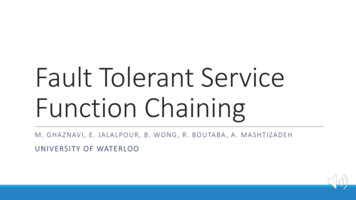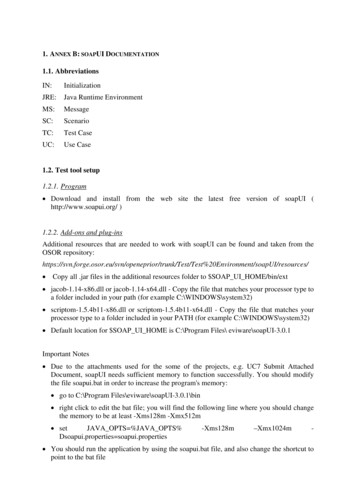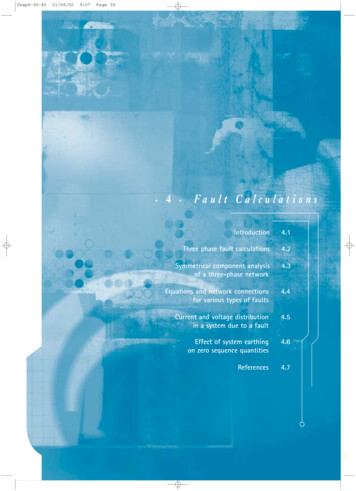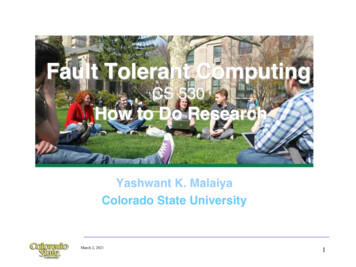
Transcription
Fault Tolerant ComputingCS 530How to Do ResearchYashwant K. MalaiyaColorado State UniversityMarch 2, 20211
Research Objective Become familiar with technical topic of currentinterest§§Current state of the artWhere the field is going (thus what to expect next) Become an expert in the field§Should be able to answer important questions Original contributions§§What needs to be doneSuggest how it would be addressed Do it (if your expertise and time allows) Present your work§Briefly (presentation) and in detail (paper)March 2, 2021Fault Tolerant Computing Y.K. Malaiya2
Project type A thorough survey of a topic, with original insight A development of a new scheme§or a fresh implementation of an existing scheme Modeling and analysis of an existing scheme.March 2, 2021Fault Tolerant Computing Y.K. Malaiya3
Steps for Identifying SourcesHow to Start a Research Work in Computer Science:A Framework For Beginners Somdip DeyMarch 2, 2021Fault Tolerant Computing Y.K. Malaiya4
Search DatabasesSecondary sources: database indexes Google Scholar§§Forward links: Paper X Cited by (example)Backward Links: Paper X cites (example) DBLP CSU Library etc.Primary (accessible through CSU Library) ACM Digital Library IEEEXplore Digital Library ScienceDirect etcMarch 2, 2021Fault Tolerant Computing Y.K. Malaiya5
Source types Journals: published several times a year§§Rigorously reviewed, long publication delayJournal, Transactions, Conferences: held once a year, proceedingspublished§Conference, Symposium, Research groups§Industry, academic, consultants: web site Industry publications§Magazines, blogs, white papers, product website Books: often well known stuff News reportsMarch 2, 2021Fault Tolerant Computing Y.K. Malaiya6
How to Read a Paper:THE THREE-PASS APPROACH The first pass: Read§§§the title, abstract, and introductionsection and sub-section headings, but ignore everything elsethe conclusions The second pass: Read§§§figures, diagrams and other illustrationsmark relevant unread references for further readingDo you need to read it in detail? The third pass: Read critically§§identify and challenge assumption and viewsLoop up references neededKeshav, S., How to Read a Paper, ACM shavA.pdfMarch 2, 2021Fault Tolerant Computing Y.K. Malaiya7
Avoid Prior BiasMarch 2, 2021Fault Tolerant Computing Y.K. Malaiya8
Key Questions What problem are you trying to solve?§Why is it important? What recent advances or interesting ideas are there?§§what have others done?what have others not done yet? What have you done (so far)?§§§What is your next step?how does it relate to your goal?why is it important? How will you know when §§you’ve made progress?you’re done?March 2, 2021William J. Rapaport, How to WriteFault Tolerant Computing Y.K. Malaiya9
Deliverables a one page proposal§motivation, brief scope of study and some specificreferences. Progress report: should have completed a majorpart of the project. slides based on findings thus far§§Post in Canvas Discussions and present in classShould demonstrate thoroughness of literature search Understanding of the key technical concepts§Peer review required final report (two column format, vericite)March 2, 2021Fault Tolerant Computing Y.K. Malaiya10
Progress report Documentation:http://www.cs.colostate.edu/ cs530dl/f18/project Progress report (3-5 pages) It should indicate thatyou have finished at least half of the work. Partial version of the final report Abstract, Background Summary of the findings What the final report will contain , any refinements ofthe objectives as a result of the recent study, Applicable references in proper format.March 2, 2021Fault Tolerant Computing Y.K. Malaiya11
Proper formatting Proper citations: IEEE/ACM format§ Including authors, title, publication, page numbers, date.Two column IEEE/ACM format§ Title, name(s) of the author(s),§ Name of the class and professor (for CS530 reports)§ Abstract§Your contribution and what is new§ Introduction (background & related work, objectives & methods),§ Assumptions/schemes/models/problem-formulation§ Comparison/discussion/derivation etc. of the results,§ Conclusions and suggestions for improvements§ References.§ Appendixes (if need)Must have diagrams and hard technical info(equations/tables/plots/screen-shots etc)March 2, 2021Fault Tolerant Computing Y.K. Malaiya12
Citing Sources“IEEE” “ACM” etc: These are professional organizations that organize numerousconferences and published journalsYou must specify the author, title of paper, specific names ofconference/journal, associated details, date, page numbersURL not needed for conference, journal publications. Neededfor on-line publications (Organizational reports, Industrialwhite-papers, News etc)Omar H., Alhazmi and Yashwant K. Malaiya, "Application of vulnerability discovery models tomajor operating systems“, IEEE Transactions on Reliability, Volume: 57 , Issue: 1, pp. 14-22,March 2008,Ambrose Andongabo, Ilir Gashi, "vepRisk - A Web Based Analysis Tool for Public SecurityData", 13th European Dependable Computing Conference (EDCC) 2017, pp. 135-138, 2017.March 2, 2021Fault Tolerant Computing Y.K. Malaiya13
You must include Title, your name, class, year, professor’s name Abstract: What does it include and why is itimportant Background: Other existing work andbackground ideas Technical discussion: detailed discussion offindings with non-text material (charts, plots,tables. algorithms etc) Discussion & Summary ReferencesMarch 2, 2021Fault Tolerant Computing Y.K. Malaiya14
Evaluation of CS530 Project ReportsSimilar to paper review for conferences/journals significance and originalitythoroughness of researchdepth of understanding displayedPresentationFinal report is submitted through Vericite using Canvas§ Checks for overlap with other documents (plagiarism)§ Some overlap OK§ Cite sources of definitions, ideas, data, figures etc.§ Any text copied and pasted must be enclosed in quotes andcited Exception: references (cite only those you have seen)March 2, 2021Fault Tolerant Computing Y.K. Malaiya15
Typical Original Research ProcessDiscussion/ Conclusion/ContributionIntroduction to Research in Computer Science - Ian WatsonMarch 2, 2021Fault Tolerant Computing Y.K. Malaiya16
March 2, 2021 Fault Tolerant Computing Y.K. Malaiya 2 Research Objective Become familiar with technical topic of current interest § Current state of the art § Where the field is going (thus what to expect next) Become an expert in the field § Should be able to answer important questions Original contributions § What needs to be done § Suggest how it would be addressed
